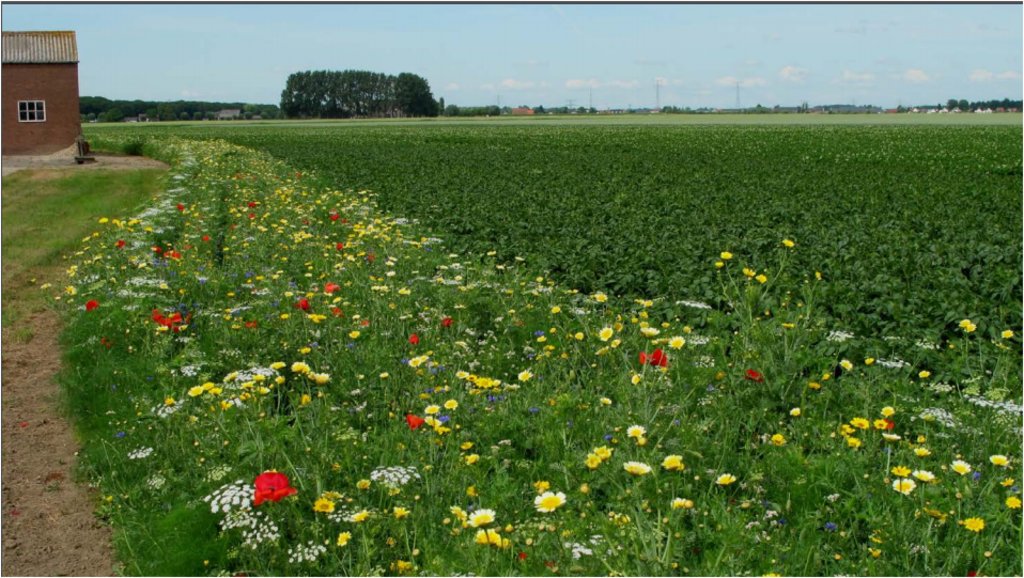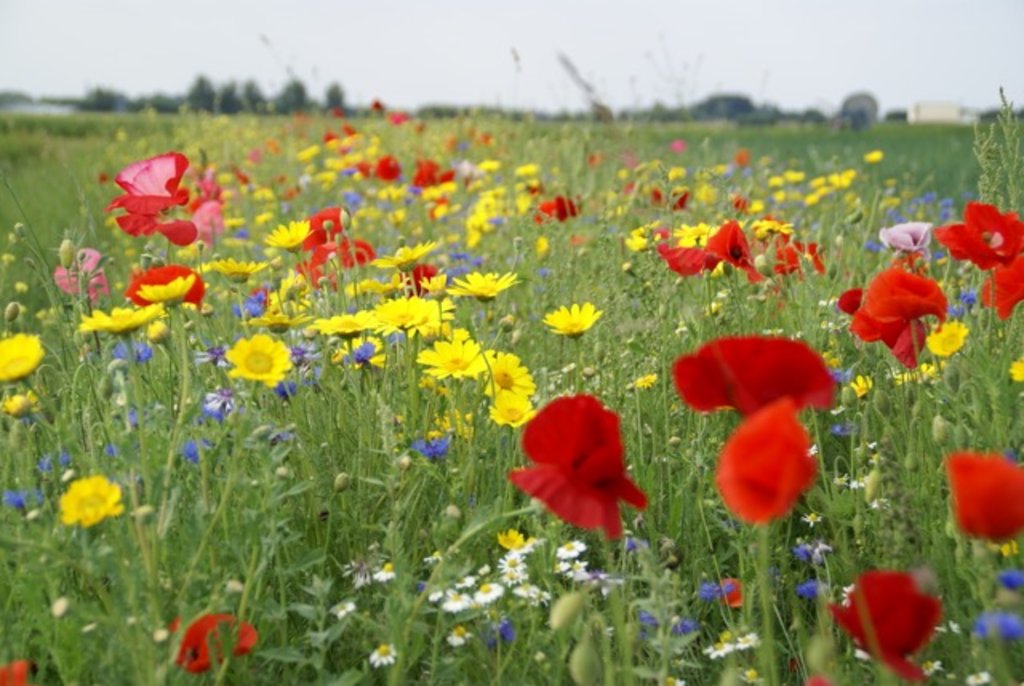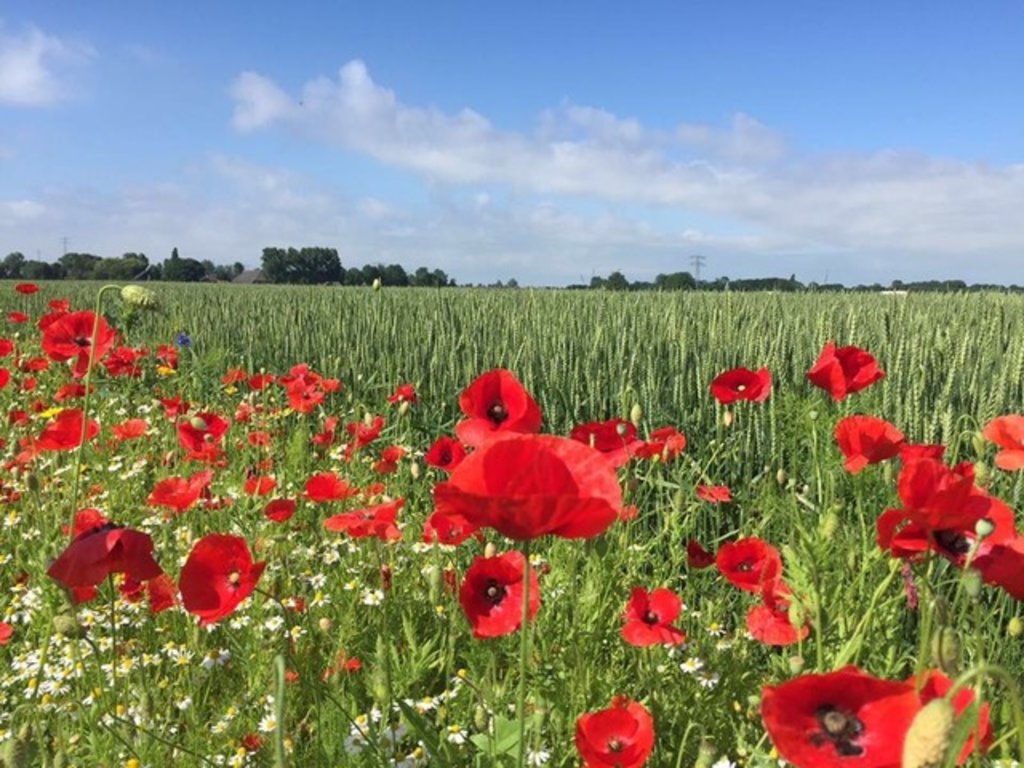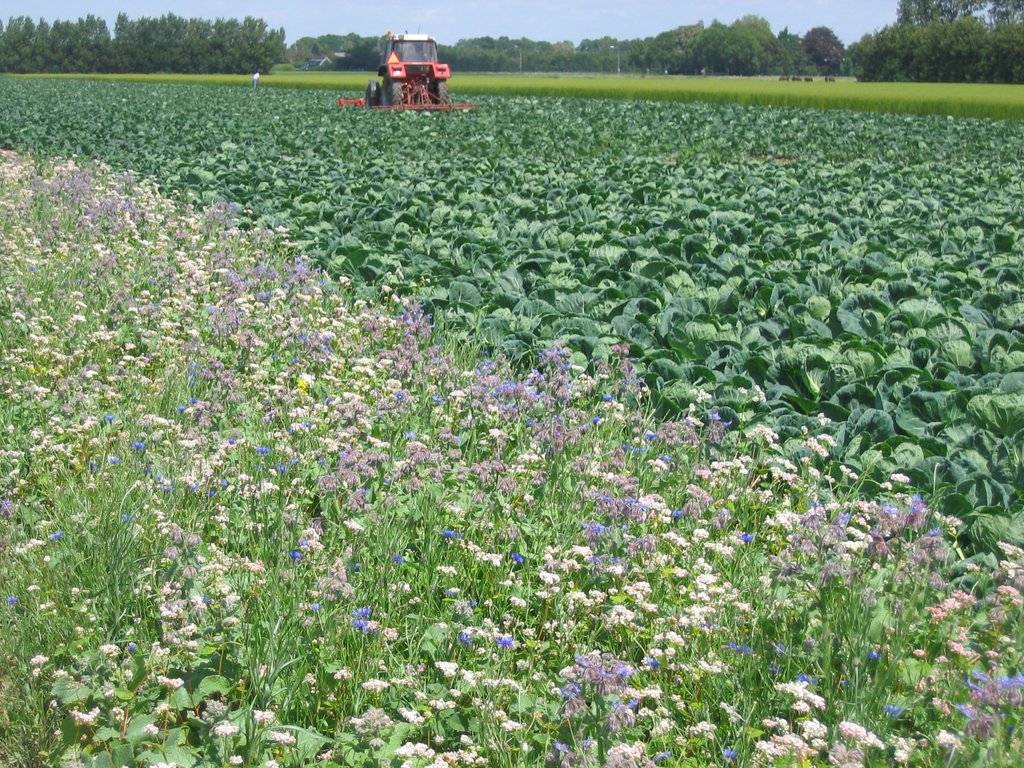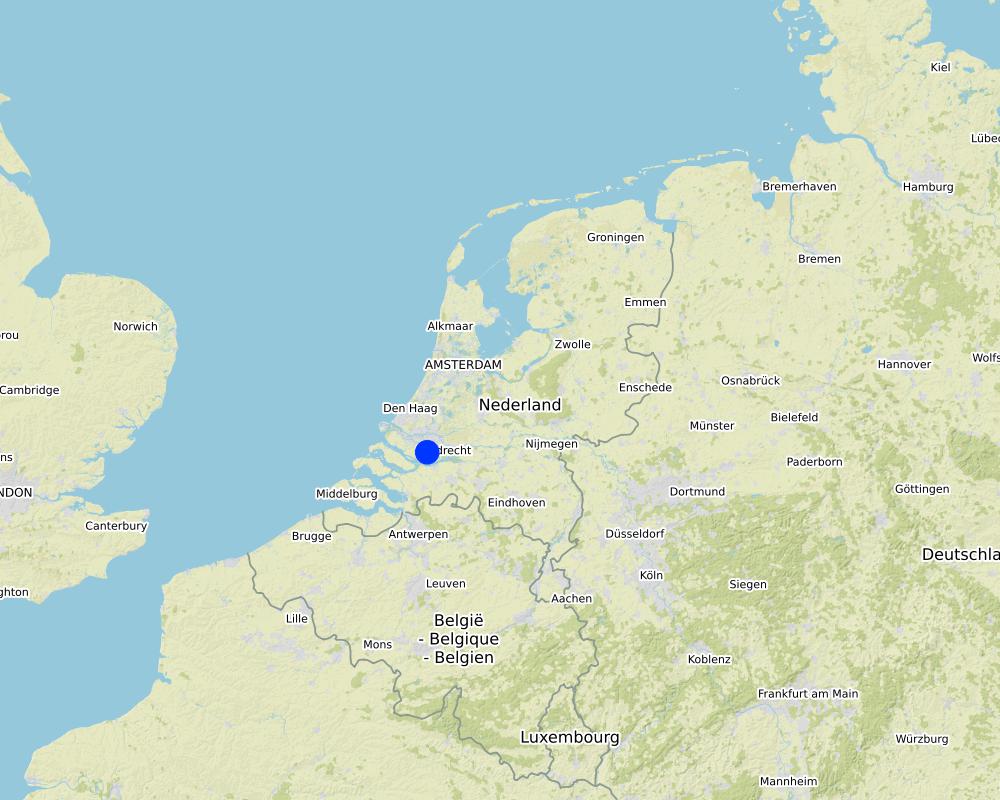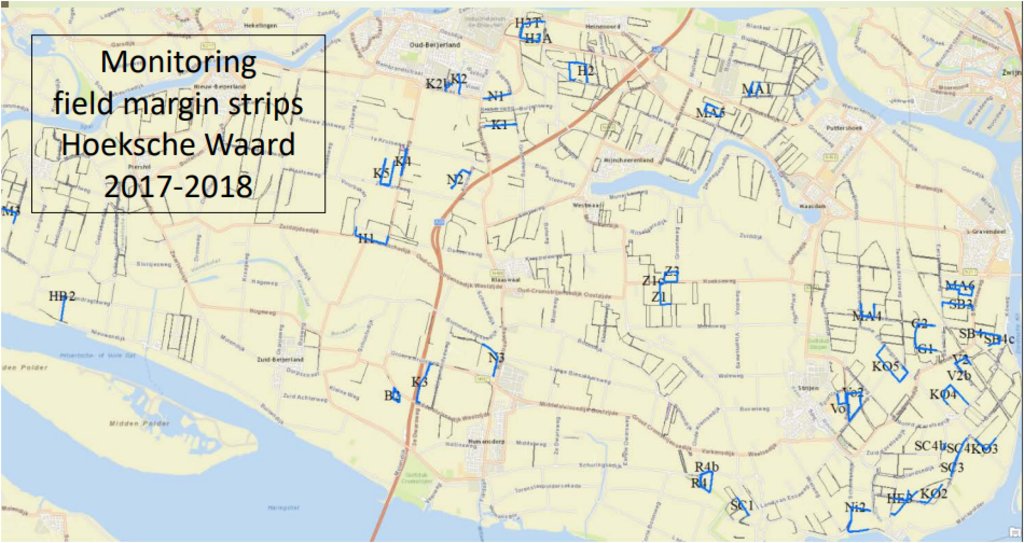Field Margin Strips [ប្រទេសហូឡង់]
- ការបង្កើត៖
- បច្ចុប្បន្នភាព
- អ្នកចងក្រង៖ Alan Radbourne
- អ្នកកែសម្រួល៖ David Robinson, David Norris, Sabine Reinsch
- អ្នកត្រួតពិនិត្យច្រើនទៀត៖ Renate Fleiner, Rima Mekdaschi Studer
Akkerrand
technologies_5187 - ប្រទេសហូឡង់
ពិនិត្យមើលគ្រប់ផ្នែក
ពង្រីកមើលទាំងអស់ បង្រួមទាំងអស់1. ព័ត៌មានទូទៅ
1.2 ព័ត៌មានលម្អិតពីបុគ្គលសំខាន់ៗ និងស្ថាប័នដែលចូលរួមក្នុងការវាយតម្លៃ និងចងក្រងឯកសារនៃបច្ចេកទេស
បុគ្គលសំខាន់ម្នាក់ (ច្រើននាក់)
co-compiler:
Van Rijn Paul
University of Amsterdam, Institute of Biodiversity and Ecosystem Dynamics (IBED)
ប្រទេសហូឡង់
អ្នកប្រើប្រាស់ដី:
Klompe Mellany
Klompe Grondbeheer
ប្រទេសហូឡង់
ឈ្មោះគម្រោងដែលបានចងក្រងឯកសារ/ វាយតម្លៃលើបច្ចេកទេស (បើទាក់ទង)
European Interreg project FABulous Farmersឈ្មោះអង្គភាពមួយ (ច្រើន) ដែលបានចងក្រងឯកសារ/ វាយតម្លៃបច្ចេកទេស (បើទាក់ទង)
UK Centre for Ecology & Hydrology (CEH) - ចក្រភពអង់គ្លេស1.3 លក្ខខណ្ឌទាក់ទងទៅនឹងការប្រើប្រាស់ទិន្នន័យដែលបានចងក្រងតាមរយៈ វ៉ូខេត
អ្នកចងក្រង និង(បុគ្គលសំខាន់ៗ)យល់ព្រមទទួលយកនូវលក្ខខណ្ឌនានាទាក់ទងទៅនឹងការប្រើប្រាស់ទិន្នន័យដែលបានចងក្រងតាមរយៈវ៉ូខេត:
បាទ/ចា៎
1.4 សេចក្តីប្រកាសស្តីពីចីរភាពនៃការពណ៌នាពីបច្ចេកទេស
តើបច្ចេកទេសដែលបានពណ៌នានេះមានបញ្ហាដែលផ្តោតលើការធ្លាក់ចុះគុណភាពដី, បើដូច្នេះវាមិនអាចត្រូវបានប្រកាសថាជាបច្ចេកទេសនៃការគ្រប់គ្រងប្រកបដោយចីរភាពទេ?
ទេ
2. ការពណ៌នាពីបច្ចេកទេស SLM
2.1 ការពណ៌នាដោយសង្ខេបពីបច្ចេកទេស
និយមន័យបច្ចេកទេស:
Create strips with flowering plants in the margins of arable fields.
2.2 ការពណ៌នាលម្អិតពីបច្ចេកទេស
ការពណ៌នា:
In the Hoeksche Waard area (Netherlands), field margin strips between 2 and 20 meters wide have been sown in the margins of arable or vegetable crop fields with a mixture of native flowering plant species, with plant species targeted to encourage certain target insect abundances. A mixture of annual flowers are sown in spring (April or May), or perennial plant mixtures (flowers and grasses) sown also in spring, or prefernetially in late summer (September). Annual flower strips produce flowers mostly in summer, whereas perennial strips produce mostly flowers in the following spring and following years.
The purpose of flower strips is to support the natural pest control and pollination by native insect species for reduced disease and increased production. Many flying natural enemies of pests require pollen and/or nectar in the adult stage for survival and reproduction, needing food on a regular basis, so must be in short range from the crop fields, i.e. in the margin of or within the field. Pollinators also need food when the crop is not flowering in order to build up a local population.
For the implementation of field margin strips to be successful, knowledge of the plant species mixtures was requried to know what would grow well in this semi-humid, deep heavy soil, agricultural environment, as well as growing well together with the right characteristics to support the target insect groups. For example, most natural enemies have small mouth parts and can only feed on nectar from shallow flowers, thus require a specific seed mix (<2 cm deep, see Van Rijn & Wäckers, Journal of Applied Ecology 2016). Here, the species were selected for their ability to support natural enemies of aphids (such as hoverflies) or wild bees, especially bumblebees. The first group includes flowers with accessible nectar (< 2 cm deep) such as Apiaceae, buckwheat, cornflower, and Asteraceae with shallow florets. The second group includes red clover, lotus and other Fabaceae, as well as Asteraceae with deeper florets (such as sunflowers). Perennial mixtures are generally supplemented with annual flowers (cornflowers and poppies) that already produce flowers the first year, as well as (slow growing) grass species (Festuca) to make the strips more robust when incidentally used as tractor paths.
Additionally for implementation, knowledge on how to effectivly use the seed sowing machines, with special care required for preparing the seed bed in advance, to prevent segregation of bigger and smaller seed in the machine, and for sowing the seeds not to deep and the field margin strips should be maintained for a number of years to allow for a local build up of beneficial insect populations. Another considertation is the farming practise and the surrounding landscape as it should provide other resources needed by the insect population, such as hibernation habitat and bee nesting sites or additional (prey and flower providing) habitats for other generations of natural enemies.
The benefits are multiple. The reduced need to use insecticides, especially against aphids, increases the capacity for pollination and reduces the need to manage honeybees, although regular scouting of pest and natural enimies in the adjacent crop field is required to ensure benefits. The strip acts as a buffer to reduce the drift of fertilisers and pesticides into adjacent ditches and water courses. And, there is a social benefit with an increased appreciaiton of the arable landscape by citizens enjoying the mosaic of flowers and crops in the landscape.
The technology overall has been a great success, yet does have a small number of draw backs to be aware of and manage effectivly. Weeds usually occur in the year of sowing and there can be some dislike of the rough nature of the vegetation compared to crop fields. To help manage these challenges field margin strips are sometimes mown while still flowering, ideally mowing is done only once a year and at the end of the growing season (September).
The compilation of this SLM is a part of the European Interreg project FABulous Farmers which aims to reduce the reliance on external inputs by encouraging the use of methods and interventions that increase the farm’s Functional AgroBiodiversity (FAB). Visit www.fabulousfarmers.eu and www.nweurope.eu/Fabulous-Farmers for more information.
2.3 រូបភាពនៃបច្ចេកទេស
2.4 វីដេអូនៃបច្ចេកទេស
ការពណ៌នាសង្ខេប:
Field margins for Functional Agro Biodiversity in the Hoeksche Waard, The Netherlands
Flowers in fieldmargins of areable farms attrack pestcontrolling insects. Flowers feed the insects by nectar and pollen. The larvae of the insects eat aphids in the crops. The flowers keep the crops free of aphids. A clever way of making use of the power of nature.
https://www.youtube.com/watch?v=w4mBTvYKVYw
កាលបរិច្ឆេទ:
28/01/2014
ទីតាំង:
Hoeksche Waard
2.5 ប្រទេស/តំបន់/ទីតាំងកន្លែង ដែលបច្ចេកទេសត្រូវបានអនុវត្ត និងបានគ្រប់ដណ្តប់ដោយការវាយតម្លៃនេះ
ប្រទេស:
ប្រទេសហូឡង់
តំបន់/រដ្ឋ/ខេត្ត:
Hoeksche Waard (Zuid-Holland)
បញ្ជាក់ពីការសាយភាយនៃបច្ចេកទេស:
- ត្រូវបានផ្សព្វផ្សាយត្រឹមតំបន់មួយ
ប្រសិនបើបច្ចេកទេសត្រូវបានសាយភាយពាសពេញតំបន់ណាមួយ បញ្ជាក់ទំហំផ្ទៃដីអនុវត្តន៍ (គិតជា គ.ម2):
150,0
ប្រសិនបើមិនច្បាស់ពីទំហំផ្ទៃដី សូមធ្វើការប៉ាន់ប្រម៉ាណ:
- 100-1,000 គម2
តើបច្ចេកទេស (មួយ ឬច្រើន) ទាំងនោះស្ថិតនៅក្នុងតំបន់ការពារជាអចិន្ត្រៃយ៍ណាមួយដែរឬទេ?
ទេ
មតិយោបល់:
The arable land in the Hoeksche Waard is ca 150 km2. A quarter of the farmers have field margin strips on their farms, with a total of ca 500 km in length.
Latitude: 51.8050
Longitude: 4.4365
Map
×2.6 កាលបរិច្ឆេទនៃការអនុវត្ត
បង្ហាញឆ្នាំនៃការចុះអនុវត្ត:
2005
2.7 ការណែនាំពីបច្ចេកទេស
សូមបញ្ជាក់តើបច្ចេកទេសត្រូវបានណែនាំឱ្យអនុវត្តដោយរបៀបណា:
- ពេលកំពុងពិសោធន៍
- តាមរយៈគម្រោង / អន្តរាគមន៍ពីខាងក្រៅ
3. ចំណាត់ថ្នាក់នៃបច្ចេកទេស SLM
3.1 គោលបំណងចម្បង (១ ឬច្រើន) នៃបច្ចេកទេសនេះ
- ធ្វើឱ្យប្រសើរឡើងនូវផលិតកម្ម
- អភិរក្សប្រព័ន្ធអេកូឡូស៊ី
- ការពារតំបន់ទីជម្រាល/តំបន់ខ្សែទឹកខាងក្រោមបញ្ចូលជាមួយបច្ចេកទេសផ្សេងទៀត
- អភិរក្ស/ធ្វើឱ្យប្រសើរឡើងជីវចម្រុះ
- បង្កើតផលប្រយោជន៍សេដ្ឋកិច្ច
- support natural pest control and improve natural pollination by native insect species
3.2 ប្រភេទដីប្រើប្រាស់មួយប្រភេទ (ច្រើនប្រភេទ) ដែលបានអនុវត្តបច្ចេកទេស
ដីប្រើប្រាស់ចម្រុះនៅលើដីតែមួយ:
ទេ

ដីដាំដំណាំ
- ដំណាំប្រចាំឆ្នាំ
ដំណាំប្រចាំឆ្នាំ - បញ្ជាក់ប្រភេទដំណាំ:
- ធញ្ញជាតិ - ស្រូវសាលី (និទាឃរដូវ)
ចំនួនសារដែលដាំដំណាំក្នុងមួយឆ្នាំ:
- 1
តើជាការអនុវត្តន៍ដំណាំចន្លោះ?
បាទ/ចា៎
ប្រសិនបើបាទ/ច៎ា សូមបញ្ជាក់ប្រភេទដំណាំដែលដាំចន្លោះគ្នានោះ:
Cereal crops and flowering strips
តើជាការអនុវត្តន៍ដំណាំវិលជុំ?
ទេ
3.3 បន្ទាប់ពីអនុវត្តបច្ចេកទេស តើដីប្រើប្រាស់មានការប្រែប្រួលដែររឺទេ?
បន្ទាប់ពីអនុវត្តបច្ចេកទេស តើដីប្រើប្រាស់មានការប្រែប្រួលដែររឺទេ?
- ទេ (បន្តទៅសំណួរ 3.4)
3.4 ការផ្គត់ផ្គង់ទឹក
ការផ្គត់ផ្គង់ទឹកនៅកន្លែងអនុវត្តបច្ចេកទេស:
- ទឹកភ្លៀង
3.5 ក្រុម SLM ដែលបច្ចេកទេសស្ថិតនៅក្នុង
- បញ្ចូលការគ្រប់គ្រងសត្វល្អិត និងជំងឺតាមបែបចម្រុះ (រួមទាំង កសិកម្មសរីរាង្គ)
- herbaceous field margin strips
3.6 វិធានការ SLM ដែលបញ្ចូលនូវបច្ចេកទេស

វិធានការរុក្ខជាតិ
- V2: ស្មៅនិងរុក្ខជាតិៗដែលដុះមានអាយុមិនលើសពី 2ឆ្នាំ

វិធានការគ្រប់គ្រង
- M7: ផ្សេងៗ
មតិយោបល់:
Applying field margin strips for pest control and improved biodiversity
3.7 កំណត់ប្រភេទនៃការធ្លាក់ចុះគុណភាពដីសំខាន់ៗដែលបច្ចេកទេសនេះបានដោះស្រាយ

ការធ្លាក់ចុះជីវសាស្ត្រនៃដី
- Bh: ការបាត់បង់ទីជំរក
- Bp: ការកើនឡើងនូវសត្វល្អិត ឬជំងឺ បាត់បង់នូវសត្វមានប្រយោជន៍
3.8 ការពារ កាត់បន្ថយ ឬស្តារឡើងវិញនៃការធ្លាក់ចុះគុណភាពដី
បញ្ជាក់ពីគោលដៅរបស់បច្ចេកទេស ដែលផ្តោតទៅការធ្លាក់ចុះគុណភាពដី:
- ការកាត់បន្ថយការធ្លាក់ចុះគុណភាពដី
4. បច្ចេកទេសជាក់លាក់ សកម្មភាពអនុវត្ត ធាតុចូល និងថ្លៃដើម
4.1 គំនូសបច្ចេកទេសនៃបច្ចេកទេសនេះ
លក្ខណៈពិសេសនៃបច្ចេកទេស (ទាក់ទងនឺងគំនូរបច្ចេកទេស):
Overview of flower margins in the Hoeksche Waard (in blue).
Field margin strips are typically 3-4 meters wide but can range between 2 and 20 meters in width. They are typically present at all margins surrounding a crop field, especially where the field is delimited by a ditch. Here the land gradient is flat, but margin strips can be applied on any gradient, and would be particually effective at the bowwom of a slope for run off buffer strip benefits.
ឈ្មោះអ្នកនិពន្ធ:
Paul van Rijn/Mellany Klompe
កាលបរិច្ឆេទ:
26/06/2019
4.2 ព័ត៌មានទូទៅដែលពាក់ព័ន្ធនឹងការគណនាធាតុចូល និងថ្លៃដើម
កំណត់របៀបនៃការគណនាថ្លៃដើម និងធាតុចូល:
- ក្នុងឯកតាបច្ចេកទេស
បញ្ជាក់ឯកតា:
1 ha
ផ្សេងៗ/ រូបិយប័ណ្ណជាតិ (បញ្ជាក់):
Euro
បើពាក់ព័ន្ធសូមកំណត់អត្រាប្តូរប្រាក់ពីដុល្លាទៅរូបិយប័ណ្ណតំបន់ (ឧ. 1 ដុល្លារ = 79.9 រៀលនៃរូបិយប័ណ្ណប្រេស៊ីល) ៖ 1 ដុល្លារ =:
0,89
កំណត់ថ្លៃឈ្នួលជាមធ្យមនៃការជួលកម្លាំងពលកម្មក្នុងមួយថ្ងៃ:
100 euro
4.3 សកម្មភាពបង្កើត
| សកម្មភាព | រយៈពេល (រដូវកាល) | |
|---|---|---|
| 1. | Creating seed bed using shallow plough to invert weeds and provide bare soil surface o sow seed | 1 month before sowing |
| 2. | Fertiliser application (as required) | Just before or with sowing |
| 3. | Sowing seed. Annual flowers are typically sown in rows (30 cm apart), allowing for mechanical weed control (once or twice) in between the rows. Perennial strips are broadcast sown (at a density of 18 kg/ha) and not weeded. | April/May or September |
| 4. | Weeding using machinery (of annual strips) | 1 month after sowing |
| 5. | Mowing using machenery | 1 month after sowing |
| 6. | Ploughing (when strips are removed or resown) | after mowing |
4.4 ថ្លៃដើម និងធាតុចូលដែលត្រូវការសម្រាប់ការបង្កើតបច្ចេកទេស
| បញ្ជាក់ពីធាតុចូល | ឯកតា | បរិមាណ | ថ្លៃដើមក្នុងមួយឯកតា | ថ្លៃធាតុចូលសរុប | % នៃថ្លៃដើមដែលចំណាយដោយអ្នកប្រើប្រាស់ដី | |
|---|---|---|---|---|---|---|
| កម្លាំងពលកម្ម | Farm worker | person-days | 2,5 | 100,0 | 250,0 | 100,0 |
| សម្ភារៈ | Tractor | machine-days | 2,5 | 50,0 | 125,0 | 100,0 |
| សម្ភារៈ | Sowing machine | machine-days | 0,75 | 50,0 | 37,5 | 100,0 |
| សម្ភារៈ | Plough | machine-days | 1,5 | 50,0 | 75,0 | 100,0 |
| សម្ភារៈ | Mower | machine-days | 0,75 | 50,0 | 37,5 | 100,0 |
| សម្ភារៈដាំដុះ | Seed mix | kg | 18,0 | 40,0 | 720,0 | |
| ជី និងសារធាតុពុល | Fertilizer | kg | 100,0 | 2,0 | 200,0 | |
| ថ្លៃដើមសរុបក្នុងការបង្កើតបច្ចេកទេស | 1445,0 | |||||
| ថ្លៃដើមសរុបក្នុងការបង្កើតបច្ចេកទេសគិតជាដុល្លារ | 1623,6 | |||||
4.5 សកម្មភាពថែទាំ
| សកម្មភាព | ពេលវេលា/ ភាពញឹកញាប់ | |
|---|---|---|
| 1. | Mowing | Once per year |
4.6 កំណត់ថ្លៃដើមសម្រាប់ការថែទាំ/ សកម្មភាពរបស់បច្ចេកទេស (ក្នុងរយៈពេលមួយឆ្នាំ)
| បញ្ជាក់ពីធាតុចូល | ឯកតា | បរិមាណ | ថ្លៃដើមក្នុងមួយឯកតា | ថ្លៃធាតុចូលសរុប | % នៃថ្លៃដើមដែលចំណាយដោយអ្នកប្រើប្រាស់ដី | |
|---|---|---|---|---|---|---|
| កម្លាំងពលកម្ម | Farm worker | person-days | 0,75 | 100,0 | 75,0 | 100,0 |
| សម្ភារៈ | Tractor | machine-days | 0,75 | 50,0 | 37,5 | 100,0 |
| សម្ភារៈ | Mower | machine-days | 0,75 | 50,0 | 37,5 | 100,0 |
| ថ្លៃដើមសរុបសម្រាប់ការថែទាំដំណាំតាមបច្ចេកទេស | 150,0 | |||||
| ថ្លៃដើមសរុបសម្រាប់ការថែទាំដំណាំតាមបច្ចេកទេសគិតជាដុល្លារ | 168,54 | |||||
4.7 កត្តាសំខាន់បំផុតដែលមានឥទ្ធិពលដល់ការចំណាយ
ពណ៌នាពីកត្តាប៉ះពាល់ចម្បងៗទៅលើថ្លៃដើម:
Seed mixture choice can vary in price and weed control can be challenging
5. លក្ខណៈបរិស្ថានធម្មជាតិ និងមនុស្ស
5.1 អាកាសធាតុ
បរិមាណទឹកភ្លៀងប្រចាំឆ្នាំ
- < 250 មម
- 251-500 មម
- 501-750 មម
- 751-1,000 មម
- 1,001-1,500 មម
- 1,501-2,000 មម
- 2,001-3,000 មម
- 3,001-4,000 មម
- > 4,000 មម
កំណត់បរិមាណទឹកភ្លៀង (បើដឹង) ជា មីលីម៉ែត្រ:
800,00
បញ្ជាក់ឈ្មោះឯកសារយោងនៃស្ថានីយឧតុនិយម:
Rotterdam
តំបន់កសិអាកាសធាតុ
- មានភ្លៀងមធ្យម
5.2 សណ្ឋានដី
ជម្រាលជាមធ្យម:
- រាបស្មើ (0-2%)
- ជម្រាលតិចតួច (3-5%)
- មធ្យម (6-10%)
- ជម្រាលខ្ពស់បន្តិច (11-15%)
- ទីទួល (16-30%)
- ទីទួលចោត (31-60%)
- ទីទួលចោតខ្លាំង (>60%)
ទម្រង់ដី:
- ខ្ពង់រាប
- កំពូលភ្នំ
- ជម្រាលភ្នំ
- ជម្រាលទួល
- ជម្រាលជើងភ្នំ
- បាតជ្រលងភ្នំ
តំបន់តាមរយៈកម្ពស់ :
- 0-100 ម
- 101-500 ម
- 501-1,000 ម
- 1,001-1,500 ម
- 1,501-2,000 ម
- 2,001-2,500 ម
- 2,501-3,000 ម
- 3,001-4,000 ម
- > 4,000 ម
បញ្ជាក់ថាតើបច្ចេកទេសនេះត្រូវបានអនុវត្តន៍នៅក្នុង:
- មិនពាក់ព័ន្ធទាំងអស់
5.3 ដី
ជម្រៅដីជាមធ្យម:
- រាក់ខ្លាំង (0-20 សម)
- រាក់ (21-50 សម)
- មធ្យម (51-80 សម)
- ជ្រៅ (81-120 សម)
- ជ្រៅខ្លាំង (> 120 សម)
វាយនភាពដី (ស្រទាប់លើ):
- ម៉ត់/ ធ្ងន់ (ឥដ្ឋ)
វាយនភាពដី (> 20 សម ស្រទាប់ក្នុង):
- ម៉ត់/ ធ្ងន់ (ឥដ្ឋ)
សារធាតុសរីរាង្គនៅស្រទាប់ដីខាងលើ:
- មធ្យម (1-3%)
5.4 ទឹកដែលអាចទាញមកប្រើប្រាស់បាន និងគុណភាពទឹក
នីវ៉ូទឹកក្រោមដី:
< 5 ម
ទឹកលើដីដែលអាចទាញយកប្រើប្រាស់បាន:
ល្អ
គុណភាពទឹក (មិនបានធ្វើប្រត្តិកម្ម):
ទឹកសម្រាប់តែការធ្វើកសិកម្ម (ស្រោចស្រព)
គុណភាពទឹក គឺផ្តោតទៅលើ៖:
ទឹកលើផ្ទៃដី
តើមានបញ្ហាភាពទឹកប្រៃហូរចូលមកដែរឬទេ?
ទេ
តើទឹកជំនន់កំពុងកើតមាននៅតំបន់នេះដែររឺទេ?
ទេ
5.5 ជីវៈចម្រុះ
ភាពសម្បូរបែបនៃប្រភេទ:
- ទាប
ភាពសម្បូរបែបនៃទីជម្រក:
- ទាប
5.6 លក្ខណៈនៃអ្នកប្រើប្រាស់ដីដែលអនុវត្តបច្ចេកទេស
នៅមួយកន្លែង ឬពនេចរ :
- នៅមួយកន្លែង
ទីផ្សារនៃប្រព័ន្ធផលិតកម្ម:
- ពាណិជ្ជកម្ម/ ទីផ្សារ
ចំណូលក្រៅកសិកម្ម:
- តិចជាង 10% នៃចំណូល
កម្រិតជីវភាព:
- មធ្យម
ឯកជន ឬក្រុម:
- ធ្វើខ្លួនឯង/ គ្រួសារ
កម្រិតប្រើប្រាស់គ្រឿងយន្ត:
- គ្រឿងយន្ត/ ម៉ាស៊ីន
យេនឌ័រ:
- ស្ត្រី
- បុរស
អាយុរបស់អ្នកប្រើប្រាស់ដី:
- វ័យកណ្តាល
5.7 ទំហំផ្ទៃដីជាមធ្យមនៃដីប្រើប្រាស់ដោយអ្នកប្រើប្រាស់ដី ក្នុងការអនុវត្តបច្ចេកទេស
- < 0.5 ហិកតា
- 0.5-1 ហិកតា
- 1-2 ហិកតា
- 2-5 ហិកតា
- 5-15 ហិកតា
- 15-50 ហិកតា
- 50-100 ហិកតា
- 100-500 ហិកតា
- 500-1,000 ហិកតា
- 1,000-10,000 ហិកតា
- > 10,000 ហិកតា
តើផ្ទៃដីនេះចាត់ទុកជាទំហំកម្រិតណាដែរ ខ្នាតតូច មធ្យម ឬខ្នាតធំ (ធៀបនឹងបរិបទតំបន់)?
- ខ្នាតតូច
5.8 ភាពជាម្ចាស់ដី កម្មសិទ្ធប្រើប្រាស់ដី និងកម្មសិទ្ធប្រើប្រាស់ទឹក
ភាពជាម្ចាស់ដី:
- ឯកជន មិនមានកម្មសិទ្ធ
កម្មសិទ្ធិប្រើប្រាស់ដី:
- កិច្ចសន្យាជួល
- ឯកជន
កម្មសិទ្ធប្រើប្រាស់ទឹក:
- ជាក្រុម (មានដែនកំណត់)
តើកម្មសិទ្ធប្រើប្រាស់ដី គឺផ្អែកលើប្រព័ន្ធច្បាប់បែបបុរាណ?
ទេ
សូមបញ្ជាក់:
land use rights are traded
5.9 ការប្រើប្រាស់សេវាកម្ម និងហេដ្ឋារចនាសម្ព័ន្ធ
សុខភាព:
- មិនល្អ
- មធ្យម
- ល្អ
ការអប់រំ:
- មិនល្អ
- មធ្យម
- ល្អ
ជំនួយបច្ចេកទេស:
- មិនល្អ
- មធ្យម
- ល្អ
ការងារ (ឧ. ការងារក្រៅកសិដ្ឋាន):
- មិនល្អ
- មធ្យម
- ល្អ
ទីផ្សារ:
- មិនល្អ
- មធ្យម
- ល្អ
ថាមពល:
- មិនល្អ
- មធ្យម
- ល្អ
ផ្លូវ និងការដឹកជញ្ជូន:
- មិនល្អ
- មធ្យម
- ល្អ
ទឹកផឹក និងអនាម័យ:
- មិនល្អ
- មធ្យម
- ល្អ
សេវាកម្មហិរញ្ញវត្ថុ:
- មិនល្អ
- មធ្យម
- ល្អ
6. ផលប៉ះពាល់ និងការសន្និដ្ឋាន
6.1 ផលប៉ះពាល់ក្នុងបរិវេណអនុវត្តបច្ចេកទេសដែលកើតមាន
ផលប៉ះពាល់លើសេដ្ឋកិច្ចសង្គម
ផលិតផល
ផលិតកម្មដំណាំ
មតិយោបល់/ ការបញ្ជាក់:
Increased crop yeild from improved pollination
គុណភាពដំណាំ
មតិយោបល់/ ការបញ្ជាក់:
Increased crop health with reduced pests
ចំណូល និងថ្លៃដើម
ការចំណាយលើធាតុចូលកសិកម្ម
មតិយោបល់/ ការបញ្ជាក់:
Less pesticides required due to better natural pest control
ចំណូលក្នុងកសិដ្ឋាន
មតិយោបល់/ ការបញ្ជាក់:
Cost of implementation offset by larger crop yield and health
បន្ទុកការងារ
មតិយោបល់/ ការបញ្ជាក់:
Implementation and management of flower strip takes longer than using whole field for single crop
ផលប៉ះពាល់ទៅលើវប្បធម៌សង្គម
សន្តិសុខស្បៀង/ ភាពគ្រប់គ្រាន់ខ្លួនឯង
មតិយោបល់/ ការបញ្ជាក់:
Less reliance on pesticide input
ឱកាសនៃការបង្កើតថ្មី
មតិយោបល់/ ការបញ្ជាក់:
Social apprication of flowers from public
ផលប៉ះពាល់ទៅលើអេកូឡូស៊ី
វដ្តទឹក/លំហូរ
គុណភាពទឹក
មតិយោបល់/ ការបញ្ជាក់:
Less pesticide use leading to less being washed into adjacent ditches
ដី
ការបាត់បង់ដី
មតិយោបល់/ ការបញ្ជាក់:
Buffer strip adjacent to ditch reduces surface run off from field
ជីវចម្រុះ៖ ដំណាំ, សត្វ
ដំណាំគម្រប
មតិយោបល់/ ការបញ្ជាក់:
Margin strips have greater land surace coverage than crops
ភាពសម្បូរបែបនៃរុក្ខជាតិ
មតិយោបល់/ ការបញ្ជាក់:
Large diversity in margins
ភាពសម្បូរបែបនៃសត្វ
មតិយោបល់/ ការបញ្ជាក់:
Habitat and forage for a range of biodoversity
ប្រភេទសត្វមានប្រយោជន៍
មតិយោបល់/ ការបញ្ជាក់:
Targeted to pollinators and natural pest control species
ភាពសម្បូរបែបនៃទីជំរក
មតិយោបល់/ ការបញ្ជាក់:
Habitat and forage for a range of biodoversity
ការគ្រប់គ្រងកត្តាចង្រៃ/ ជំងឺ
មតិយោបល់/ ការបញ្ជាក់:
Targeted to improve natural pest control species
6.2 ផលប៉ះពាល់ក្រៅបរិវេណអនុវត្តបច្ចេកទេសដែលកើតមាន
Buffering/សមត្ថភាពចម្រោះ
មតិយោបល់/ ការបញ្ជាក់:
Buffer strip adjacent to ditch reduces surface run off from field of soil, fertilisers and chemicals
6.3 ភាពប្រឈម និងភាពរួសនៃបច្ចេកទេសទៅនឹងការប្រែប្រួលអាកាសធាតុ និងគ្រោះអាកាសធាតុ/ គ្រោះមហន្តរាយ (ដែលដឹងដោយអ្នកប្រើប្រាស់ដី)
គ្រោះអាកាសធាតុ (មហន្តរាយ)
គ្រោះមហន្តរាយជីវៈសាស្ត្រ
| លក្ខណៈឆ្លើយតបនៃបច្ចេកទេសទៅនឹងការប្រែប្រួលអាកាសធាតុ | |
|---|---|
| ការមានបញ្ហាសត្វល្អិត/ដង្កូវ | ល្អណាស់ |
6.4 ការវិភាគថ្លៃដើម និងអត្ថប្រយោជន៍
តើផលចំណេញ និងថ្លៃដើមត្រូវបានប្រៀបធៀបគ្នាយ៉ាងដូចម្តេច (ទស្សនៈរបស់អ្នកប្រើប្រាស់ដី)?
រយៈពេលខ្លី:
អវិជ្ជមានតិចតួច
រយៈពេលវែង:
ប៉ះពាល់តិចតួចបំផុត
តើផលចំណេញ និងការថែទាំ/ ជួសជុលត្រូវបានប្រៀបធៀបគ្នាយ៉ាងដូចម្តេច (ទស្សនៈរបស់អ្នកប្រើប្រាស់ដី)?
រយៈពេលខ្លី:
អវិជ្ជមានតិចតួច
រយៈពេលវែង:
ប៉ះពាល់តិចតួចបំផុត
មតិយោបល់:
Evaluation based on no subsidies; with subsidies the returns are balanced or slightly positive.
6.5 ការទទួលយកបច្ចេកទេស
- 11-50%
ក្នុងចំណោមគ្រួសារទាំងអស់ដែលបានអនុវត្តបច្ចេកទេស តើមានប៉ុន្មានគ្រួសារដែលចង់ធ្វើដោយខ្លួនឯង ដោយមិនទទួលបានសម្ភារៈលើកទឹកចិត្ត/ប្រាក់ឧបត្ថម្ភ?:
- 0-10%
6.6 ការបន្សុំា
តើថ្មីៗនេះ បច្ចេកទេសនេះត្រូវបានកែតម្រូវដើម្បីបន្ស៊ាំទៅនឹងស្ថានភាពប្រែប្រួលដែរឬទេ?
បាទ/ចា៎
ផ្សេងៗ (សូមបញ្ជាក់):
changing CAP subsidy regulations
បញ្ជាក់ពីការបន្ស៊ាំនៃបច្ចេកទេស (ការរៀបចំ, ឧបករណ៍/ប្រភេទ ។ល។):
CAP subsidy regulations are financial supports for land management, changes since technology implementation have supported the use of flower margin strips making the implementaiton more favorable. More general information on CAP can be found here: https://ec.europa.eu/info/food-farming-fisheries/key-policies/common-agricultural-policy/cap-glance_en#documents
6.7 ភាពខ្លាំង/ គុណសម្បត្តិ/ ឱកាសនៃបច្ចេកទេស
| ភាពខ្លាំង/ គុណសម្បត្តិ/ ឱកាសនៅកន្លែងរបស់អ្នកប្រើប្រាស់ដី |
|---|
| Use of land difficult for agricultural practices can be used |
| Community building when implemented across an area, connecting farmers together and connection to the public who appreciate more flowers in thier landscape |
| ភាពខ្លាំង/ គុណសម្បត្តិ/ ឱកាស ទស្សនៈរបស់បុគ្គលសំខាន់ៗ |
|---|
| New habitat for wildlife, including pollinators and natural pest controls: increased numbers of flowering plants increased numbers of bees, hoverflies and natural enemies |
| Multifunctionality of flower margins makes them more cost effective; e.g. flower margins close to ditches increases macrofauna diversity in waters |
| Bufferzone for surface water pollution |
| Recreational (human health) benefits |
6.8 ភាពខ្សោយ/ គុណវិបត្តិ/ ហានិភ័យនៃបច្ចេកទេស និងវិធីសាស្ត្រដោះស្រាយ
| ភាពខ្សោយ/ គុណវិបត្តិ/ ហានិភ័យ ទស្សនៈរបស់អ្នកប្រើប្រាស់ដី | តើបច្ចេកទេសទាំងនោះបានដោះស្រាយបញ្ហាដូចម្តេច? |
|---|---|
| Additional work & costs sowing and maintaining the flower margins compared to leaving the areas unused | Community effort of the Hoeksche Waard reduces individual efforts |
| ភាពខ្សោយ/ គុណវិបត្តិ/ ហានិភ័យ ទស្សនៈរបស់អ្នកចងក្រងឬបុគ្គលសំខាន់ៗ | តើបច្ចេកទេសទាំងនោះបានដោះស្រាយបញ្ហាដូចម្តេច? |
|---|---|
| Without subsidy the implementation costs can be prohibitive | Ensure subsidies available for continued sustainable land use. |
7. ឯកសារយោង និងវេបសាយ
7.1 វិធីសាស្ត្រ/ ប្រភពនៃព័ត៌មាន
- តាមការចុះទីវាល ការស្រាវជ្រាវនៅទីវាល
farmer-centric meetings in the Hoeksche Waard
- ការសម្ភាសន៍ជាមួយអ្នកប្រើប្រាស់ដី
farmer-centric meetings in the Hoeksche Waard
មតិយោបល់:
Compiled during 2019-20 to summarise implementation between 2005 - 2019.
7.3 ការភ្ជាប់ទៅកាន់ព័ត៌មានពាក់ព័ន្ធលើប្រព័ន្ធអនឡាញ
ចំណងជើង/ ពណ៌នា:
Research on field margins by the University of Amsterdam
វេបសាយ:
https://ibed.uva.nl/content/news/2019/02/importance-of-flower-strips-in-arable-fields.html?1570545036515
ការតភ្ជាប់ និងម៉ូឌុល
ពង្រីកមើលទាំងអស់ បង្រួមទាំងអស់ការតភ្ជាប់
គ្មានការតភ្ជាប់
ម៉ូឌុល
គ្មានម៉ូឌុល



